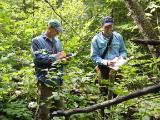Corridor Data Resources
Corridor Data Resources
Effective conservation of corridors relies on credible scientific data—and lots of it. The more data, the better the outcome. At a minimum, scientists, land planners, transportation authorities, and anyone interested in conserving corridors need current information on plants and animals that includes their distribution, life history, habitat requirements, and conservation status.
Corridor conservation also requires a lot of non-biological data such as landscape features and infrastructure data, such as location of roads and structures. Where does one source such information? Increasing amounts of data and software are available online and we present here some good places to begin the search.
Relevant Data Sources
Corridor Design
This volunteer-run project launched by several corridor scientists with funding from the University of Arizona aims to provide education and resources for corridor designers. The website provides extensive literature on the process of designing corridors and is notable for offering free downloads of its proprietary software, CorridorDesigner. The powerful modeling software helps planners in creating habitat and corridor models using ArcGIS.
DataBasin Corridor Center
Data Basin is a powerful, online mapping system that provides for free all necessary components to create meaningful GIS maps, including datasets, tools, and expertise.
Members can utilize mapping software; upload their own projects to share with others; and engage in discussion groups. Data Basin is a potent tool for corridor conservation.
The NatureServe Network
Comprising 82 natural heritage programs and conservation data centers in all 50 United States, Canada, and Latin America, the NatureServe network collects and manages detailed local information about the plants, animals, and ecosystems of the Americas. NatureServe and its member programs also provide information products, data management tools, and biodiversity expertise that help meet local, national, and global conservation needs. The public, private, and nonprofit sectors all rely on NatureServe’s objective scientific information about species and ecosystems to make informed decisions about land use and natural resource management.
NatureServe Explorer
Launched in 2001, this free resource provides reliable scientific information on the conservation status, taxonomy, distribution, and life history of more than 70,000 plants and animals and information and nearly 7,000 habitats in the United States and Canada. This authoritative data draws on more than 35 years of field work and observation by the NatureServe Network of natural heritage programs.
USGS NBII
The National Biological Information Infrastructure (NBII) is a collaborative program run by the U.S. Geological Survey's Biological Informatics Office to provide increased access to data and information on the nation's biological resources.
The NBII serves as a hub of biological databases, information products, and analytical tools maintained by NBII partners and other contributors in government agencies, academic institutions, non-government organizations, and private industry.


